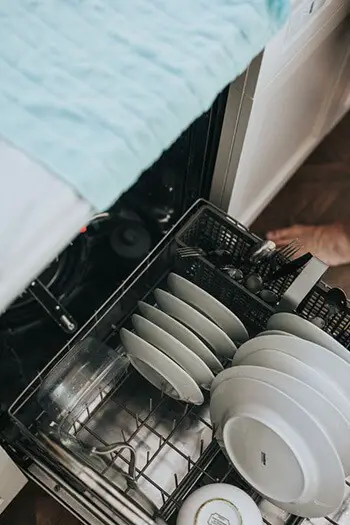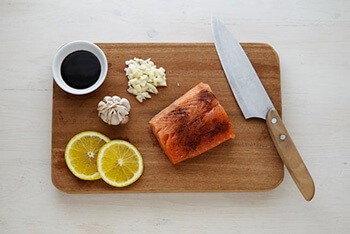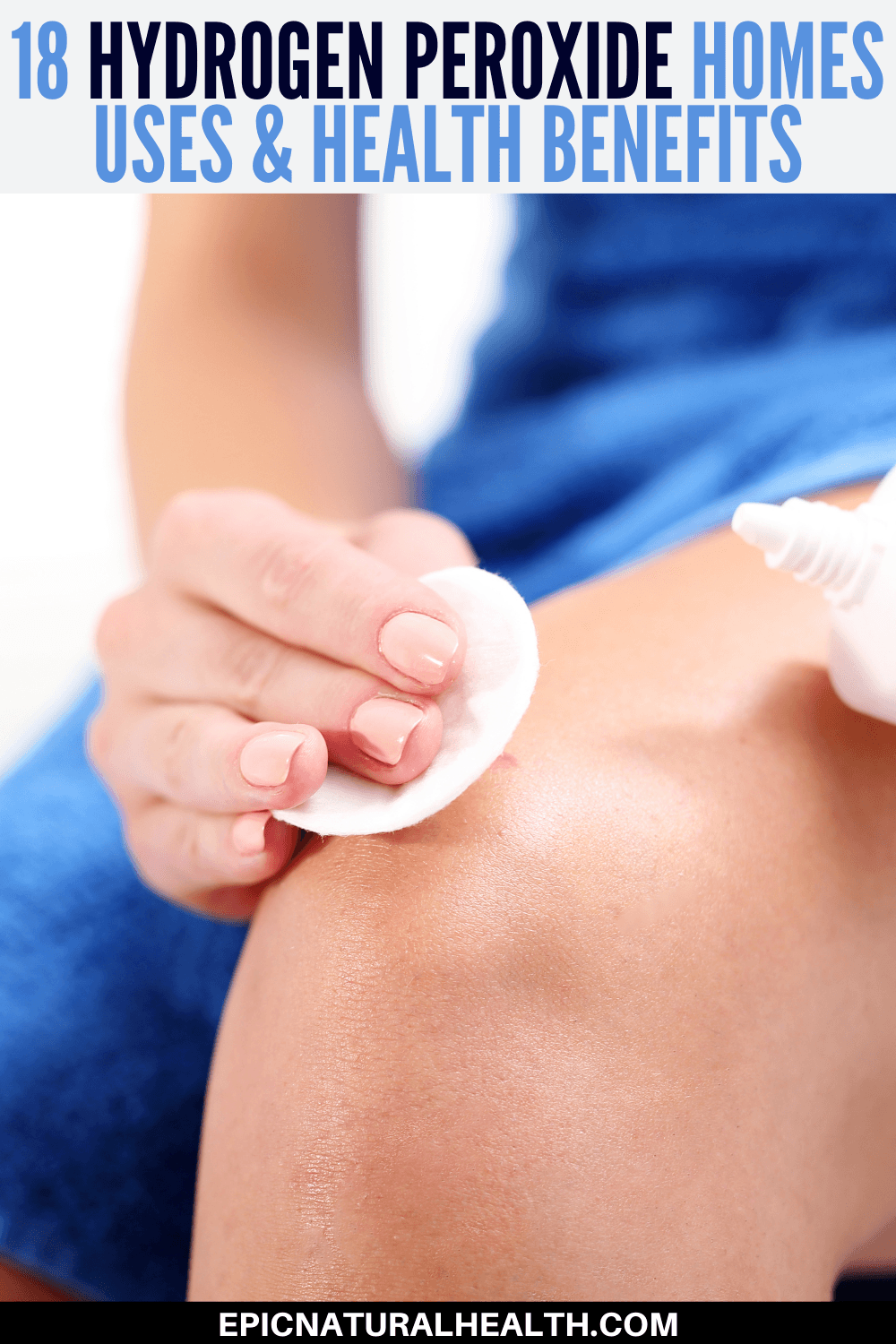What Is It?
Hydrogen peroxide is a household chemical that’s actually very similar to water. The only difference is that it has an extra oxygen molecule, which makes it a very powerful oxidiser and versatile cleaner, as well as giving it its distinctive blue colour.
Generally, hydrogen peroxide is considered a relatively risk-free cleaner, as it breaks down quickly when it comes into contact with air or water. Still, knowing how to use hydrogen peroxide safely, and when, is key to being able to make the most out of the formula. It’s been used for nearly a century, with many of its uses backed by science – but it’s worth knowing which methods are still relevant today to help you to stay safe.
Stay tuned for the top uses of hydrogen peroxide, and the health benefits it provides– plus the things you really shouldn’t be using hydrogen peroxide for.
Hydrogen peroxide home uses
1. Cleaning your dishwasher

After several consecutive weeks of use, your dishwasher won’t look so clean anymore. You might notice a musty smell emitting from it, or you may accidentally touch the dreaded dishwasher surface slime.
The best way to keep the nasties at bay is to disinfect your dishwasher with hydrogen peroxide. Simply add a quarter cup of three percent hydrogen peroxide to your appliance before you close the door to run a load.
2. Sanitising your chopping boards

It’s not enough to simply wash your chopping boards under warm water and hope for the best, especially if you own wooden chopping boards, which bacteria can easily seep into and linger. To prevent cross-contamination, you can use hydrogen peroxide to kill any hidden bacteria, cleaning your chopping boards all the way through.
Simply spray your boards with undiluted hydrogen peroxide. Let it sit for a minute or two, and then rinse clean.
3. Whitening t-shirt armpit stains
We’ve all experienced the annoyance of washing a white shirt multiple times, only for those yellow-ish sweaty armpit stains to remain. Rather than throw out your shirt entirely, you can quickly resolve the issue by using hydrogen peroxide.
4. Cleaning smelly towels

After a while of use, bath towels can take on a fairly distinctive damp odour, which doesn’t seem to go away, no matter how much laundry detergent you wash them in. Luckily, washing your towels in hydrogen peroxide should make them smell much fresher and cleaner.
Combine half a cup of hydrogen peroxide and half a cup of white vinegar together with your smelly towels in the washing machine. Fill the machine with hot water and your regular detergent, and allow the towels to soak for 15 minutes before continuing the cycle as normal.
5. Sanitising children’s toys

Hydrogen peroxide is a sanitiser, which makes it a great tool to have around if you need to give your kiddie toys a deep clean before use. Just combine one part hydrogen peroxide with three parts warm water in a bowl, then leave toys, lunchboxes, and other plastic items to soak for an hour or so.
Remove from the water, wash in more warm water, and leave them out to dry.
6. Scrubbing your sinks
Your kitchen and bathroom sink will take on a thin layer of grime fairly quickly if you don’t keep on top of cleaning. A good way to making your cleaning efforts last longer is to scrub your sinks with hydrogen peroxide.
Just wash out the surface of your sink with warm water, then scrub it with baking soda sprinkled onto a sponge. When you’ve covered the whole surface, pour three percent hydrogen peroxide over the surface and allow it to sit for ten minutes before rinsing it clean with more warm water.
7. Washing your veggies

It’s always best to buy your veggies as natural and organic as possible, but the mud, dirt, and other microorganisms that may remain on their surfaces might be harmful to consume. To remove bacteria and avoid falling ill from your foods, use one-third of a cup of three percent hydrogen peroxide per gallon of water.
If you’re washing delicate skinned vegetables like lettuces, just soak for 20 minutes and then rinse. Tougher skinned veggies can be soaked 30 minutes before rinsing and drying. This should also keep them fresher for longer in your fridge.
8. Scouring cookware
Nothing stays clean with use, as proven by the contents of our kitchen cupboards. If you’re struggling to keep your cookware items grime-free, it might be time to treat them with a powerful hydrogen peroxide soak.
Any oven trays, pots, and pans that have a baked-on layer of brown can be cleaned by first sprinkling with baking soda, then spritzing the soda with three percent hydrogen peroxide. Let them soak for up to three hours before wiping away the grime.

9. Removing germs from your garbage bins
Nobody enjoys deep cleaning their bins, and one easy way to keep things fresher for longer is by using hydrogen peroxide. Clean the inside of your bin with warm, soapy water as you would normally do, then spray the whole container with a solution of one part water to one part hydrogen peroxide.
Let your bin dry in the sun for several hours, which should evaporate the hydrogen peroxide.
10. Deep cleaning your toilet

If trying to keep your toilet sparkling at all times feels like mission impossible, you need to equip yourself with some better deep cleaning tools. Hydrogen peroxide works particularly well in this case, as a disinfectant and a pretty tough cleaner.
It’s said to microorganisms, including bacteria, yeasts, fungi, viruses, and spores, so obviously, it’s a good choice for your toilet. Just add half a cup of three percent hydrogen peroxide to your toilet, then leave it for 20 minutes to get the full benefit.
11. Killing mould and mildew
Even with our best efforts, mould and mildew are recurring problems for most homeowners around the world. If you don’t want to use a product that will send toxic fumes around your home in order to kill them, hydrogen peroxide should do the trick.
12. Cleaning out your pet’s litter tray
There’s no pleasant way of cleaning out your pet’s litter tray, but if you want to get rid of any bacteria and odour, hydrogen peroxide is a good cleaning option. First empty the litter as you would normally, then wash the container out with soap and hot water.
Next, spray the whole container thoroughly with full-strength hydrogen peroxide. Let it sit for up to fifteen minutes before rinsing with warm water, drying, and replacing the litter.

Hydrogen peroxide health benefits
If you want to use hydrogen peroxide for your health and not your home, you’ll need to look for a food-grade formula, which won’t contain certain stabilizers that can cause harm if ingested. Some of the best uses of hydrogen peroxide for health benefits include:
1. Breath freshening
As the hydrogen peroxide is a disinfectant, it can kill germs and bacteria in your mouth, making it an effective mouth wash. Simply mix two parts water with one part three percent hydrogen peroxide and swill the solution around your mouth for 30 seconds.
2. Treating a sore throat
Gargling with hydrogen peroxide can also help soothe a sore throat, as it can help your body fight off bacterial infections that often cause the issue. Use the same ratio of hydrogen peroxide to water, but this time, tilt your head back and let the mixture sit in your throat.
Gargle for 30 seconds, then spit. Repeat twice a day.
3. Whitening teeth

Hydrogen peroxide is the main active ingredient in many over the counter and professional teeth-whitening products, so you may as well use your own hydrogen peroxide formula for a fraction of the price. Gargling with hydrogen peroxide will make your teeth look whiter for a few hours right after you do it.
Use a one-part peroxide to two parts water formula, and swill around your teeth for 30 seconds.
4. Curing acne
A number of skincare products also include hydrogen peroxide as an ingredient, as it is thought to make an effective acne treatment. Because of its antibacterial properties, experts think that hydrogen peroxide can kill the bacteria on your skin and help to dry up sebum.
To use, mix three parts water with one part hydrogen peroxide and splash gently onto your affected areas of skin. Follow with a warm water wash and pat your face dry with a soft towel. Repeat morning and night for the best effects.
5. Treating ear infections

Hydrogen peroxide has been used as a natural remedy for earaches for many years, thanks to its ability to kill any bacteria, yeasts, fungi, and other microorganisms that can cause the problem. To use this method of treatment, carefully put several drops of hydrogen peroxide into your affected ear. Let it sit for up to five minutes before letting it drain into a sink and rinsing your ear with clean, distilled water.
6. Eliminating foot fungus
If you suffer from foot fungal infections, like athlete’s foot, hydrogen peroxide is a good treatment for eliminating the cause of the issue. It’s been proven in studies to effectively kill the fungus on the surface level of the foot, as well as any bacteria that could cause an infection.
Simply pour or dab hydrogen peroxide directly onto the affected area. It might sting on open wounds, so keep it away from skin that’s cut or bleeding.
What NOT to use hydrogen peroxide for
There are many cases of hydrogen peroxide being used for its supposed benefits around the home when it can actually do more harm than good. Cleaning out your fish tank is one of these.
While hydrogen peroxide may be fine for some fish, experts think that some species of ornamental fish, including gourami and suckermouth catfish, can’t tolerate it. Always speak to a fish veterinarian before you add hydrogen peroxide to your tank’s water.

Another use of hydrogen peroxide that is considered outdated nowadays is as an ointment for wounds or skincare. Doctors have discovered that hydrogen peroxide can actually lead to dangerous complications and can slow healing time, so it will probably end up leading to further problems down the line.
Conclusion
If you’ve got a bottle of unopened hydrogen peroxide lying around in your kitchen cupboard, now you finally know what to do with it! Remember to always dilute hydrogen peroxide when recommended, and only use the food-grade stuff for health purposes.
If you want to purchase Hydrogen Peroxide then check out the bestsellers below -
- First aid antiseptic (32 fluid ounces); helps prevent the risk of infection from minor cuts, scrapes, and burns
- 3% hydrogen peroxide formula
- Paraben and phthalate free
- No rubber latex
- One 16-fluid ounce bottle of first aid antiseptic
- First aid to help prevent risk of infection from minor cuts, scrapes and burns
- Active ingredient: 3% hydrogen peroxide (stabilized)
- If you like Swan Hydrogen Peroxide, we invite you to try Amazon Basics 3% Hydrogen Peroxide First Aid Antiseptic
- Twelve 16-fluid ounce bottles of first aid antiseptic
- First aid to help prevent risk of infection from minor cuts, scrapes and burns
- Active ingredient: 3% hydrogen peroxide (stabilized)
- If you like Swan Hydrogen Peroxide, we invite you to try Amazon Basics 3% Hydrogen Peroxide First Aid Antiseptic
- Pack of 2
- Contents inside box may be substituted with equivalent products in different brand names
- Local antiseptic to treat minor cuts and abrasions
- 16 ounce





